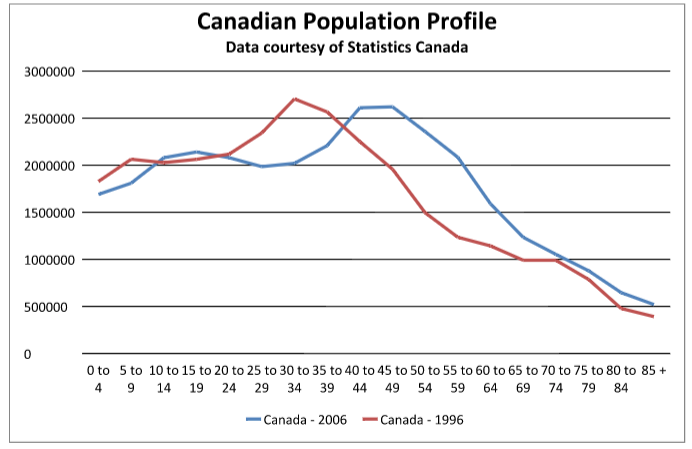
Wellness: Converting Knowledge into Wisdom

If a picture is worth a thousand words, then a graph has got to be worth millions.
The graph included here illustrates the change in the Canadian population between 1996 and 2006. The peak is, of course, the Baby Boomers. The wonderful thing about demography is its predictability; the frustrating thing may be its relentlessness. We are watching a wave of change come over us and we know it is going to further pressure an already overstressed health care system. As the Boomers age, key questions emerge:
- How are patient characteristics and consumption patterns changing?
- How are workforce characteristics changing?
- What are the consequences to patient care?
- What are the consequences to workforce wellness?
The Knowledge
We know per capita health care spending increases and will continue to increase from the patient age of 45 onwards [1]. We know health care has a comparatively high proportion of mature workers, with greater than 39% of health care workers over the age of 45 as of 2001 [2] leaving the sector vulnerable to a shortage of skilled, experienced workers at a time when demand is peaking. We can see that the number of workers entering the workforce is relatively smaller that the number of workers currently in the workforce.
Graph your own workplace age distribution and compare it to local and provincial information. The graph provided reflects the national profile; however significant variations exist between provinces. Alberta (one of Canada’s younger populations) is not dealing with the same pressures as Québec (one of Canada’s older populations). For this reason, the implementation of effective practices must be thoughtful. Project forward 5, 10 or even 15 years. How will your workplace age distribution change? What specific challenges will emerge for your practice and wellness?
The Wisdom
It isn’t going to get easier if we wait.
Health care is a large, complex sector with considerable political, economic and technological influences. As tempting as it may be to focus primarily on these influences, the workplace wellness issues currently facing health care are not going to improve on their own given these changing demographic realities. Mine the collective WISDOM of your team: What are the many ways that we can foster workplace wellness in the face of these changing circumstances?
Notes:
- Meara, White and Cutler, “Trends in Health Care Spending by Age, 1963-1999”, March 2003.
- Francois Lamontagne, “Demographic Profile of the Natural Resources Sector”, Canadian Labour and Business Centre.


